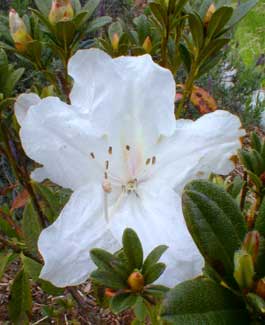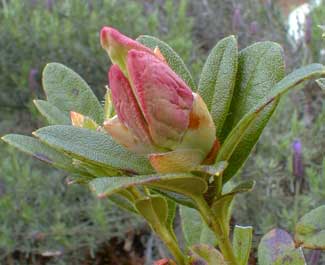 Rhododendron formosum var formosum
Rhododendron formosum var formosum
"Under the eaves, conferring drowsily,
Doves droop or amble; the agile waterfly
Wrinkles the pool: & flowers, gay & dun,
Rose, bluebell, rhododendron, one by one,
The buccaneering bees prove busily."
-George Herbert Clarke
(1873-1953)
(1873-1953)
Rhododendron formosum is native of Northeast India & Northwest Burma, at elevations of about 2,000 feet in the Himalayas, frequently in stony ground. The name "formosum" means "beautiful" rather than Formosa/Taiwan, although another species-rhody, the similarly named R. formosanum is named for its native island.
 The first publication of information about this species was in Nathaniel Wallich's Plantae Asiaticae Rariores (1830-1832) wherein is recounted the collection of a specimen in India by a certain Mr. Smith in 1815.
The first publication of information about this species was in Nathaniel Wallich's Plantae Asiaticae Rariores (1830-1832) wherein is recounted the collection of a specimen in India by a certain Mr. Smith in 1815.It was long regarded as a hothouse rhody unsuited for the open garden, until someone actually attempted it & found the species tougher than supposed, hardy for zones 7 & 8. Even though it can be tender in heat or cold (it does not like sustained temperatures below ten degrees Fahrenheit), it has a complete liking for the moderate climate of the Puget Sound region.
This little species-rhody is a 1993 recipient of the Award of Garden Merit, given to plants that are no trick to grow & which rarely disappoint. Wide-open trumpet-flowers are white with flushes of apricot or pink, with one, two, or up to six six inflorescences per truss.
These are large, deep trumpets for such a small shrub with medium-small leaves. They start out as well-colored buds but by the time the trumpets are fully opened, they are mainly white.
This shrub has bristled mature evergreen leaves & bristled young branches. It can be damaged by very cold winters, but for summers it is a little more heat-hardy than average, & likes full sun.
Most sources say this shrub is very fragrant, others say it is non-fragrant, so it may be quite variable for R. formosum var formosum, although a form with a yellow blotch, R. formosum var inaequale is reliably redolent. I could detect no particular scent from the young specimen which I installed in a friend's garden with other species-rhodies.
Its ten-year height is variable, but it'll grow four to six feet easily, & expect very old specimens to have reached ten feet. It has an open, upright habit, somewhat compact in bright shade or sunlight, but lanky if grown in too much shade. Flowering time tends to be in May but it has a bit of a range (April to June) depending on strain. The one I photographed bloomed late April.